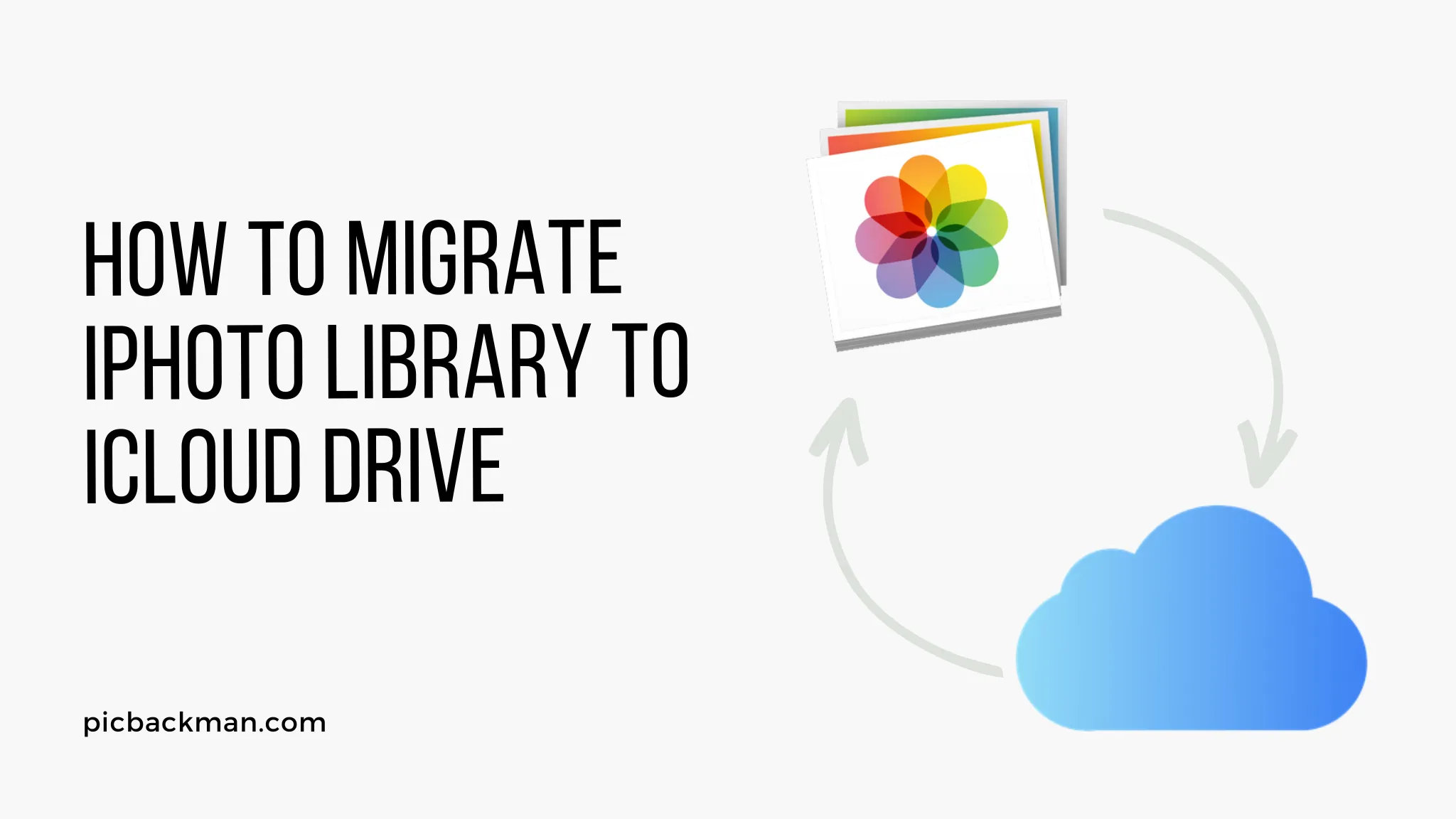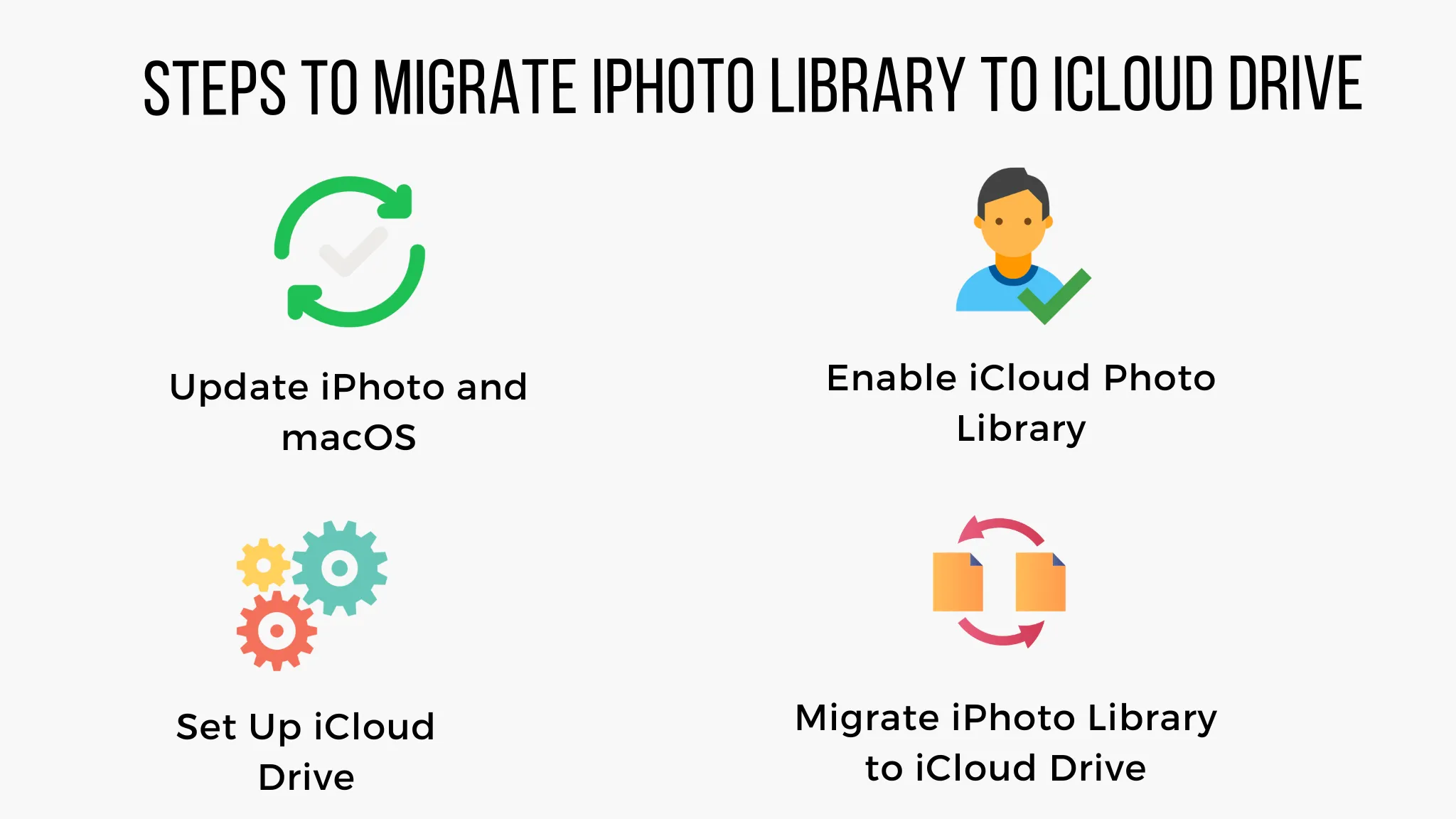
Why is it the #1 bulk uploader?
- Insanely fast!
- Maintains folder structure.
- 100% automated upload.
- Supports RAW files.
- Privacy default.
How can you get started?
Download PicBackMan and start free, then upgrade to annual or lifetime plan as per your needs. Join 100,000+ users who trust PicBackMan for keeping their precious memories safe in multiple online accounts.
“Your pictures are scattered. PicBackMan helps you bring order to your digital memories.”
How to Migrate iPhoto Library to iCloud Drive?


In this digital age, where we capture and store countless precious moments through our photographs, it's essential to have a reliable and secure storage solution.
Apple's iCloud Drive offers a seamless way to store and access your photos across multiple devices, ensuring they are backed up and available whenever you need them.
If you have been using iPhoto as your primary photo management tool, migrating your iPhoto Library to iCloud Drive can provide numerous benefits. This article will guide you through the process, step by step, to help you seamlessly migrate your iPhoto Library to iCloud Drive.
Before we dive into the migration process, let's understand the two key components: iPhoto Library and iCloud Drive. iPhoto Library is Apple's native photo management application, allowing users to organize, edit, and share their photos.
On the other hand, iCloud Drive is a cloud-based storage service provided by Apple that allows users to store and sync their files across multiple devices.
Understanding iPhoto Library and iCloud Drive
iPhoto Library serves as a centralized location for all your photos. It organizes your photos into events, albums, and smart albums, making it easier to navigate and find specific photos.
iCloud Drive, on the other hand, allows you to store files, including your iPhoto Library, in the cloud. By migrating your iPhoto Library to iCloud Drive, you can free up space on your local device and access your photos from any device connected to your iCloud account.
Steps to Migrate iPhoto Library to iCloud Drive

Follow these steps to migrate your iPhoto Library to iCloud Drive:
Step 1: Update iPhoto and macOS
Before initiating the migration process, ensure that you have the latest version of iPhoto and macOS installed on your device. This will help prevent any compatibility issues during the migration process.
Step 2: Set Up iCloud Drive
If you haven't already set up iCloud Drive on your device, follow these steps:
- Go to "System Preferences" on your Mac.
- Click on "Apple ID" and sign in with your Apple ID.
- In the sidebar, select "iCloud."
- Check the box next to "iCloud Drive" to enable it.
Step 3: Enable iCloud Photo Library
To enable iCloud Photo Library on your Mac:
- Open the "Photos" app on your Mac.
- Go to "Photos" in the menu bar and select "Preferences."
- Click on the "iCloud" tab.
- Check the box next to "iCloud Photo Library" to enable it.
Step 4: Migrate iPhoto Library to iCloud Drive
To migrate your iPhoto Library to iCloud Drive:
- Open the "Photos" app on your Mac.
- Go to "Photos" in the menu bar and select "Preferences."
- Click on the "iCloud" tab.
- Click on the "Upgrade" button next to "iCloud Photo Library."
- Follow the on-screen instructions to complete the migration process.
Note: The time required for the migration process depends on the size of your iPhoto Library and the speed of your internet connection. Ensure that you have a stable and reliable internet connection throughout the migration process.
Backup & Transfer your Photos in Minutes
Trusted by users in 125+ countries.
Quick Tip to ensure your Photos never go missing
Photos are precious memories and all of us never want to ever lose them to hard disk crashes or missing drives. PicBackMan is the easiest and simplest way to keep your photos safely backed up in one or more online accounts.
Simply Download PicBackMan (it's free!), register your account, connect to your online store and tell PicBackMan where your photos are - PicBackMan does the rest, automatically. It bulk uploads all photos and keeps looking for new ones and uploads those too. You don't have to ever touch it.
Troubleshooting Common Issues
During the migration process, you may encounter some common issues. Here are a few troubleshooting tips to help you overcome them:
Issue 1: Insufficient iCloud Storage
If you don't have enough iCloud storage to accommodate your entire iPhoto Library, consider upgrading your iCloud storage plan. Apple provides various storage plans to suit different needs and budgets.
Issue 2: Slow Internet Connection
A slow internet connection can prolong the migration process. Ensure that you have a stable and fast internet connection during the migration. Consider performing the migration process when your network traffic is low to maximize speed.
Issue 3: Compatibility with Older iPhoto Versions
If you're using an older version of iPhoto, you may face compatibility issues during the migration process. It's recommended to update to the latest version of iPhoto before attempting to migrate your library to iCloud Drive.
Tips for a Smooth Migration Process
Here are some tips to ensure a smooth migration process:
Tip 1: Backup Your iPhoto Library
Before initiating the migration, it's crucial to create a backup of your iPhoto Library. This ensures that you have a copy of your photos in case any issues arise during the migration process.
Tip 2: Check Available iCloud Storage
Verify the amount of available iCloud storage before migrating your iPhoto Library. This will help you determine if you need to upgrade your storage plan or optimize your photo library to fit within the available storage space.
Tip 3: Optimize Photos for iCloud
To reduce the size of your iPhoto Library and optimize it for iCloud, you can choose to optimize the storage on your Mac. This feature allows your Mac to store smaller, device-sized versions of your photos locally while keeping the full-resolution versions in iCloud.
Conclusion
Migrating your iPhoto Library to iCloud Drive offers numerous benefits, including seamless syncing, increased storage capacity, anywhere access, and enhanced security. By following the step-by-step process outlined in this article, you can seamlessly migrate your iPhoto Library to iCloud Drive and enjoy the convenience and peace of mind that iCloud provides for your valuable photo collection.
FAQs
1. How do I upload my entire iPhoto library to iCloud?
To upload your entire iPhoto library to iCloud, follow these steps:
- Open the "Photos" app on your Mac.
- Go to "Photos" in the menu bar and select "Preferences."
- Click on the "iCloud" tab.
- Check the box next to "iCloud Photo Library" to enable it.
- Wait for the upload process to complete. The time required depends on the size of your library and your internet connection speed.
2. How do I copy my entire iPhoto library to an external hard drive?
To copy your entire iPhoto library to an external hard drive, you can follow these steps:
- Connect the external hard drive to your Mac.
- Open a new Finder window.
- In the sidebar, under "Devices," you should see your external hard drive listed. Click on it to open it.
- Now, open another Finder window and navigate to your iPhoto library location. By default, it should be in the "Pictures" folder.
- Drag and drop the entire iPhoto library folder from its original location to the external hard drive window.
3. How long does it take to upload the iPhoto library to iCloud?
The time it takes to upload your iPhoto library to iCloud depends on the size of your library and the speed of your internet connection. Larger libraries and slower internet speeds will naturally take longer. It's best to ensure you have a stable and fast internet connection to speed up the upload process.
4. Can you have multiple iPhoto libraries on iCloud?
No, iCloud does not support multiple iPhoto libraries. You can only have one iPhoto library associated with your iCloud account. However, you can have multiple photo libraries using the Photos app on your Mac by creating separate libraries and switching between them.
5. Is there a way to merge iPhoto libraries?
Yes, you can merge iPhoto libraries using the Photos app on your Mac. Follow these steps:
- Open the Photos app on your Mac.
- Go to "File" in the menu bar and select "Import."
- Navigate to the location of the iPhoto library you want to merge and select it.
- Follow the on-screen instructions to import the photos into your current Photos library.
- Repeat the process for any additional iPhoto libraries you want to merge.
6. Is the Photos library connected to iCloud?
Yes, the Photos library is connected to iCloud if you have enabled iCloud Photo Library. This means that any changes you make to your Photos library, such as adding or deleting photos, will be synced across all devices connected to your iCloud account. It ensures that your Photos library is accessible and up to date on all your Apple devices.





